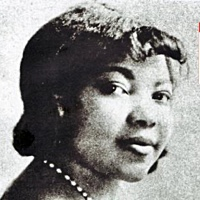Home » Jazz Musicians » Sippie Wallace
Sippie Wallace
Sippie Wallace, "The Texas Nightingale," was one of the major blues artists of the 1920s, whose renown as a performer carried well into the 1980s. Wallace was respected as both a blues singer and songwriter. Such original songs as "Mighty Tight Woman" and "Women Be Wise," which found new audiences with younger music listeners in the 1970s, are earthy and self-assertive blues songs. She is best remembered, however, as one of the foremost interpreters of the blues. Possessing a mellow and tuneful voice, she had the qualities of shading and inflection in her singing that marked the classic blues artist.
One of Wallace's specialties was the "shout," a precursor to the modern blues, in which the singer often repeats two lines of a song, and improvises a third. Wallace, who frequently sang without a microphone, was influenced by blues great Ma Rainey, yet developed a style all her own. In her earliest work she attempted to project a vocal weightiness similar to that of Ma Rainey. Later she sang in a manner better suited to the lighter, prettier qualities of her voice. Wallace composed most of her own songs, which are notable for the shapeliness and dignity of their melodies."
Wallace learned music in her father's Baptist church in Houston, Texas, where she played the organ and sang gospel music. She was nicknamed "Sippie" because, as she states, "my teeth were so far apart and I had to sip everything." Around 1910, she moved with her family to New Orleans, where Sippie's brother George W., Jr., a professional musician and composer, lived. The Wallace’s later returned to Houston, and while she was in her late teens she began performing with traveling tent shows. Wallace learned blues and ragtime music in the shows, in addition to performing in chorus lines and acting in comedy skits. These experiences influenced her contributions as a blues artist.
In the 1920s, Wallace gained a national reputation as a recording artist, working with Okeh Records in Chicago. She recorded a number of solo albums, and also worked with other jazz greats, including Louis Armstrong and Sidney Bechet. She continued theatrical touring in the 1920s, and frequently worked with another brother, Hersal, himself a respected jazz pianist. In 1929 Wallace settled in Detroit, where she would live for the rest of her life. In the 1930s she became active again in gospel music, and played the organ and sang for the Leland Baptist Church. Wallace only occasionally recorded in the 1940s through early 1960s.
Read moreTags
New Releases From Stacey Kent, Angela DeNiro With Ron Aprea Big Band, Cory Weeds, Emmet Cohen, Janet Evra, Vocalist Birthday Celebrations & More

by Mary Foster Conklin
This broadcast includes new releases from Stacey Kent, Angela DeNiro with the Ron Aprea Big Band, Emmet Cohen feat. Houston Person, Cory Weeds, Janet Evra and Defne Sahin, with birthday shoutouts to blues women Sippie Wallace, Ethel Waters, vocalists Carmen Lundy, Kurt Elling, Gregory Porter, Julia Lee, Lauren Henderson and Jane Monheit, among others. Thanks for listening and please support the artists you hear by seeing them live and online. Purchase their music so they can continue to distract, comfort, ...
Continue ReadingYou Got To Know How - New Releases Plus a Celebration of Blueswoman Sippie Wallace

by Mary Foster Conklin
This broadcast presents new releases from Judy Niemack, Rebecca Coupe Franks, Harve S, Roni Ben-Hur & Sylvia Cuenca, Aubrey Johnson, Nikki Yanofsky plus a single from säje (Sara Gazarek, Amanda Taylor, Johnaye Kendrick, Erin Bentlage), with birthday shoutouts to Sippie Wallace, Lani Hall, Lauren Henderson, Kurt Elling, Anne Sajdera, Gregory Porter, among others. Also more selections from Terri Lyne Carrington's New Standards 101 Lead Sheets by Women featuring compositions by Sherrie Maricle, Renee Rosnes and Anat Cohen. Thanks for listening ...
Continue Reading































